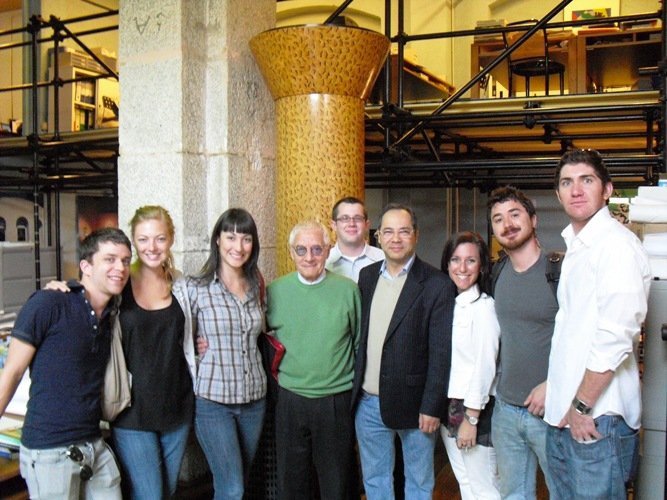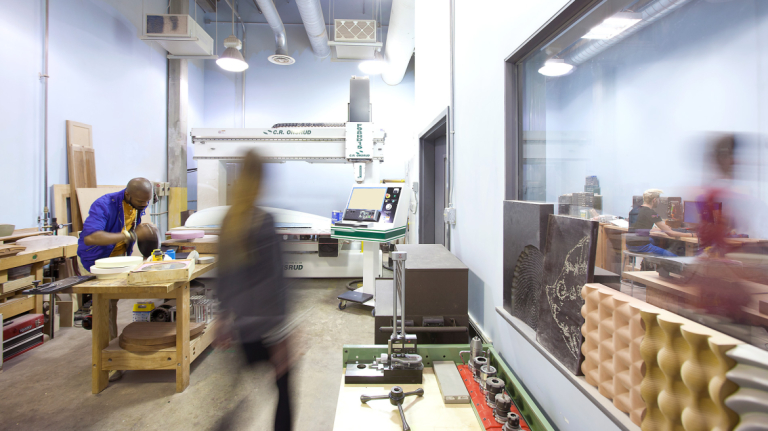My friend — and internationally respected designer, artist, consultant, and educator — Antonio Larosa embodies the convergence of Italian design mastery and American innovation. Immersed in Italy’s rich design tradition from childhood, Antonio ventured to the U.S. in the 90s, pioneering efforts to introduce high-end Italian aesthetics through groundbreaking showrooms and consultancy work.

Antonio Larosa

Antonio and fellow SCAD students pictured with renowned designer and architect Alessandro Mendini.
His prolific career has spanned disciplines like architecture, furniture, interiors, graphics, and more for an impressive clientele — from furniture manufacturers to the Italian government trade commission. But Antonio’s most transformative work may be in design education itself.

In a 2010 trip to Salone del Mobile, Antonio took ten SCAD students to tour design studios, furniture factories, leather tanneries, and even had the group inducted into the town of Meda!

As Department Chair at SCAD, he revolutionized how the next generation of furniture designers is taught. Prioritizing original creativity over trend-following, Antonio’s visionary curriculum integrated hands-on manufacturing realities. Under his guidance, SCAD’s program flourished into one of America’s premier institutes.

SCAD’s Furniture Design Facility
Now based in Phoenix, Antonio remains a dynamic force. He curates cutting-edge exhibitions, competitions, and dialogues to elevate design’s role across art, business, and contemporary culture. His multidisciplinary career exemplifies design’s seamless integration into every personal expression and living facet.

Jamaica Collection, designed by Antonio Larosa for Florida-based Benchmark Contract Furniture.
So, when I had the chance to discuss the future of our industry with Antonio, I leaped at the opportunity. Our conversation covered the importance of sustainability, technology’s disruptive potential, reviving hands-on craftsmanship, and reforming design education.
Antonio: ” I believe that furniture design is at a crossroads. We see a widening gap between high-quality craftsmanship and mass-produced, low-cost items. It’s concerning how the middle ground is disappearing.”
Me: “Absolutely. It feels like we’re losing the essence of what makes design special. But what do you think is driving this shift?”
Antonio: “It’s largely due to market forces, consumer demand, and a lack of appreciation for the design process. Many consumers gravitate towards cheap or expensive products, with little in between.”
Me: “That’s an interesting point. I’ve also noticed that vintage pieces are becoming more sought-after. Do you think there’s a resurgence in appreciation for craftsmanship through that?”
Antonio: “Definitely. Vintage pieces carry a history and quality that’s hard to find in today’s market. However, it’s ironic that even ‘vintage’ is being redefined to include barely a few years old items.”
Me: “It seems like a reflection of our broader societal trends, where the middle class is shrinking. This affects everything, including how we value and afford our living spaces and the items within them.”
Antonio: “True. And there’s another aspect worth discussing: the environmental and sustainable design. The future of furniture needs to focus on technology, sustainability, and customization.”
Me: “I couldn’t agree more. However, I worry about the loss of design diversity. If everything is either high-end or low-end, where does that leave innovation?”
Antonio: “That’s the challenge. We’re losing the platform for mid-level, innovative design that can bridge these extremes. There’s a need for a revival in genuine creativity and craftsmanship.”
Me: “Speaking of creativity, what’s your take on the role of designers today? Especially in the U.S. where it feels like celebrity endorsements are valued more than actual design skills.”
Antonio: “The situation is quite dire. In Europe, designers are celebrated for their creativity and influence on culture. In the U.S., however, the market is dominated by celebrity-driven brands, overshadowing the true art of design.”
Me: “It’s a cultural issue, then. We seem to prioritize fame over talent, and it’s affecting the quality and innovation in furniture design.”
Antonio: “Exactly. The key is to educate both the market and the upcoming designers about the value of authentic design. This includes a shift in how design is taught in schools, focusing more on creativity and less on production skills alone.”
Me: “Education seems to be at the heart of this. How do we foster a new generation of designers who can think beyond the current market limitations?”
Antonio: “It starts with respect. Respect for the craft, respect for innovation, and respect for the designers. Companies need to collaborate more closely with designers to bring fresh ideas to life.”
Me: “That sounds like a path forward. Let’s hope the industry takes note and begins to value design for its true worth.”

Designers, manufacturers, educators, and consumers must make intentional choices today to shape the industry for decades. We have the power to return furniture design to its essence — enriching spaces and lives with beauty, function, and purpose.
Our conversation reminded me that furniture design’s true spirit lies in its ability to fearlessly adapt, evolve, and inspire. By championing creativity, sustainability, and expert craftsmanship above all else, we can unlock a future where furniture is celebrated as both art and innovative industry. The choice is ours to make.
